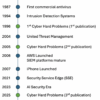Cyberattacks continue to rise, impacting businesses across industries and of all sizes. The severity of cyberattacks is only growing too – in fact, the number of businesses that have experienced a data breach of more than $1M has increased significantly year-over-year, rising from 27% to 36%. Along with costly business disruption, cyberattacks can also result in the loss of consumer trust. According to Statista Research, 56% of consumers said they are not likely at all to trust a company that had experienced a breach with their personal data involved. Organizations must improve their cyber resilience – not just for the sake of business operations, but to maintain customer confidence.
Providing Security Awareness Training
Employees are an organization’s most important asset, but they can also be a vulnerability when it comes to cybersecurity. One of the top causes of cybersecurity incidents is human error, but organizations can overcome and mitigate this risk by investing in regular cybersecurity awareness and training programs. When organizations invest in a good training program and education, cybersecurity risk can be reduced from 60% to as low as 10%.
A comprehensive training program should ensure all employees know how to recognize phishing emails, avoid suspicious links, understand the importance of strong passwords and report suspicious activity, right as it happens. Furthermore, whenever possible, training programs should include cyberattack simulations. By including simulations in training programs, employees can put tangible skills into practice and are empowered with confidence to better respond in the face of an attack. Workforces that implement effective cybersecurity training alongside simulations can recover faster from cyber incidents and improve resilience in the long term.
To build a culture of security throughout the entire workforce, all employees, from entry-level to executives, should be involved in cyber education and training programs. Given the cybersecurity landscape is constantly evolving, employees should receive continuous education and training on emerging threats and best practices, so they have the skills needed to handle the next cyber threat.
Incorporating Endpoint Protection & DNS Filtering
Organizations can also improve their cyber resilience by incorporating solutions such as endpoint protection and DNS filtering into their security strategy. Real endpoint protection ensures that every device connected to a corporate network is secured. Laptops, smartphones and tablets used for not only professional purposes, but also individual reasons, can open doors for attackers to hack into sensitive company data. With real endpoint protection, employees can trust that their personal devices are secure, aiding in strengthening the entire organization’s security framework.
Leveraging DNS filtering enables companies to have a layer of protection that defends employees from phishing attempts and malware, whether they’re accessing corporate accounts or personal email. DNS filtering protects individuals from accessing malicious websites that could compromise individual and corporate information, whether on purpose or by accident. Given that employees often navigate between personal and work-related websites, it is essential to ensure all harmful websites are blocked. By implementing these solutions, organizations can ensure they are not just protecting corporate data and information but also prioritizing the individual security of every employee.
Establishing a Business Continuity Plan
Even with a proactive cybersecurity approach, businesses are not safe from cyber incidents, and they must be prepared to respond and have a proper plan in place. By implementing a business continuity plan, organizations can test and validate how to keep operations going if a technology or vendor shuts down. These plans establish response and recovery processes that organizations can follow if a cyber incident should occur. This can involve having defined scenarios simulated continuously to ensure an organization is prepared for a future cyberattack or another issue.
Organizations should also implement continuous monitoring and threat detection, which enables businesses to analyze network traffic and detect any unusual activity that could pose a security threat. With automated alerts and real-time responses, organizations can quickly address any suspicious activity, mitigating potential damage before it impacts their customers.
Regardless of the business size or scale of operations, cyberthreats are always looming, but there are preventative steps organizations can take to lessen the impact. Investing in employee training and implementing solutions like DNS filtering and endpoint protection can ensure businesses are better prepared when faced with a cyberthreat. By taking a proactive cybersecurity approach, organizations can increase their cyber resilience, mitigating business disruption and ensuring customers remain confident and trust the organization.






